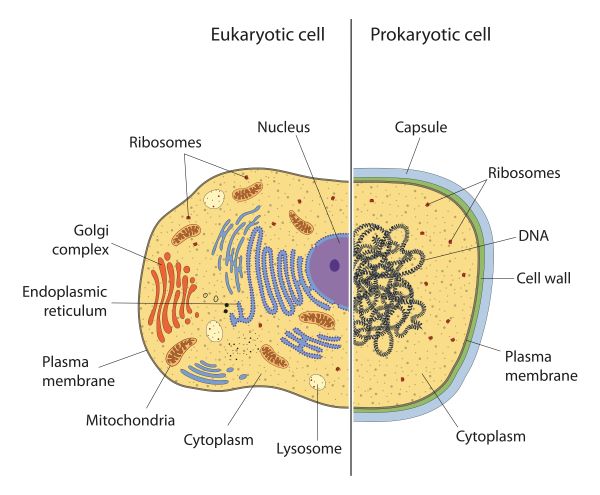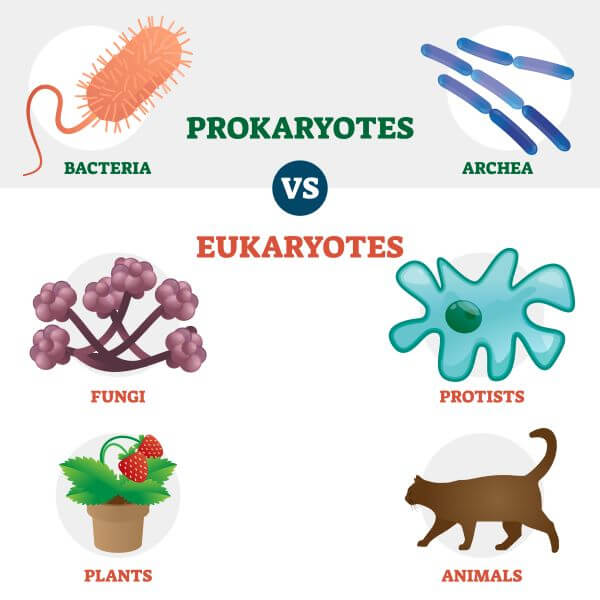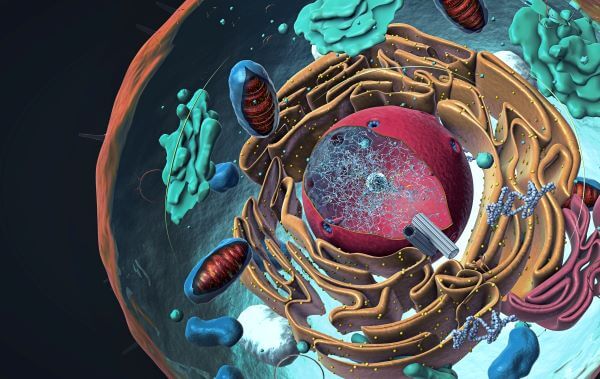All cells on Earth can be divided into two types: prokaryotes and eukaryotes. Prokaryotes are always unicellular organisms and may be bacteria or archaea. Eukaryotes may be unicellular or multicellular and include plants, animals, fungi, and protists are all made up of eukaryotic cells.
Eukaryotic cells are much larger and more complex than prokaryotes and contain several cell structures and organelles that are missing from prokaryotic cells.
Prokaryotes |
Eukaryotes |
|
| Types of organelles | No nucleus or other membrane-bound organelles | Nucleus and membrane bound organelles |
| DNA storage | Nucleoid region with free-floating DNA | DNA stored in nucleus |
| Unicellular vs. multicellular | Always unicellular | Can be unicellular or multicellular |
| Types of organisms | Bacteria, archaea | Plants, animals, fungi, protists |
| Cell size | 0.2-2.0 µm in diameter | 10-100µm in diameter |
| Type of cell division | Binary fission | Mitosis and meiosis |
| Type of reproduction | Asexual | Sexual |

What Are Prokaryotes and Eukaryotes?
Prokaryotes and eukaryotes are both types of cells; in fact, they’re the only two cell types on Earth. Prokaryotic organisms are always unicellular and may be bacteria or archaea. Eukaryotic organisms, however, may be unicellular or multicellular and include plants, animals, fungi, and protists.

Differences Between Prokaryotes and Eukaryotes
Eukaryotic cells are more complex than prokaryotic cells, and there are several structural differences between the two.

Storage of DNA
The main difference between prokaryotes and eukaryotes is that eukaryotes contain membrane-bound organelles, and prokaryotes do not. This means that prokaryotes do not have a nucleus; instead, they keep their DNA in a cell region called the nucleoid. Unlike the eukaryotic nucleus (which is surrounded by a nuclear envelope) the nucleoid is membrane-less, so the DNA is free-floating in the cytoplasm.
Organelles and DNA Storage
Eukaryotic cells contain a variety of cell structures and organelles that are absent in prokaryotes. These include:
- Mitochondria
- Golgi apparatus
- Nuclei
- Lysosomes
- Chloroplasts
- Endoplasmic reticulum

Cell Size
Prokaryotic cells are much smaller than eukaryotic cells because they don’t have to fit as many organelles inside. Prokaryotes typically measure 0.2 – 2.0µm in diameter, whereas eukaryotic cells are 1 – 100 µm in diameter.
Types of Organisms
There are only two types of prokaryotic organisms on Earth, and those are bacteria and archaea. Eukaryotes are far more diverse and include animals, plants, fungi, and protists.
Reproduction
Prokaryotes reproduce asexually and usually divide by binary fission. During this process the cell splits in two, producing two genetically-identical daughter cells. Single eukaryotic cells reproduce via mitosis or meiosis, while multicellular eukaryotic organisms typically reproduce sexually.
The Cell Wall
Most prokaryotes have a cell wall. This is a rigid structure that surrounds and protects the cell, helping it to keep its shape. In prokaryotes, the cell wall is made of peptidoglycan (AKA murein).
In eukaryotes, animals don’t have a cell wall but plant cells do. The plant cell wall is primarily made of cellulose, rather than peptidoglycan.
Similarities Between Prokaryotes and Eukaryotes
There are plenty of differences between prokaryotic and eukaryotic cells, but that doesn’t mean they have nothing in common. All cells share the following features: a cell membrane, DNA, cytoplasm, and ribosomes.

A Cell Membrane
The cell membrane (AKA the plasma membrane) is the structure that keeps the contents of a cell separate from its external environment. Prokaryotes may not have membrane-bound organelles, but they are surrounded by a cell membrane.
DNA
They may store it differently, but eukaryotes and prokaryotes both contain DNA. Without it, the cells could not produce proteins, transmit genetic material to daughter cells, or function properly.
Cytoplasm
All cells contain cytoplasm. This is the jelly-like substance that cushions the organelles and helps the cell to keep its shape.
Ribosomes
Eukaryotic and prokaryotic cells both contain ribosomes (the organelles responsible for protein synthesis). However, ribosomes are larger and more complex in eukaryotic cells.
The Origin of Prokaryotes and Eukaryotes

Prokaryotes are the oldest life forms on Earth and came into existence long before eukaryotes graced the planet. The first prokaryotes are thought to have appeared at least 3.8 billion years ago, whereas eukaryotes only emerged 2.7 billion years ago. This means that, by the time eukaryotes came along, prokaryotes had been alive and evolving for 1-1.5 billion years.
It’s difficult to know exactly where eukaryotes came from, but the leading hypothesis is that they evolved as a result of endosymbiosis. The endosymbiotic theory suggests that cell organelles like mitochondria and chloroplasts were once independent organisms that formed symbiotic relationships with other prokaryotes. At some point, they were engulfed by larger prokaryotes and lived inside them. Over many years of evolution, the two became so dependent on one another that they could no longer live alone, and complex eukaryotic cells were formed as a result.
This theory is supported by the fact that both mitochondria and chloroplasts contain their own DNA and that, like bacteria, they reproduce by splitting in two.
